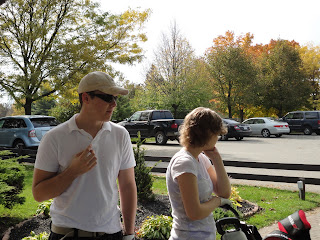Two weeks ago, on a Friday afternoon my washing machine stopped spinning. In fact, it was completely seized. Try as I might to coax another cycle, it wasn't going to budge. Six weeks ago the same thing happened, so Tom and Peter hauled it out to the garage to check it out. Everything is sealed up, so replacing a part wasn't an option. So they hauled it back in, and it started to work again.
Every now and then the spin cycle didn't spin, but I could try again, and it would. Except, not the last day.
I looked at the cost of new machines, and went "eek!" We are trying to keep two households running, and money isn't exactly growing on trees right now. So when Tom returned from his business trip I had to let him know the bad news.
Well, fortunately for us, Tom is always scheming. I don't know how his mind works, exactly, but I'm sure glad it works differently than mine. When we first moved to Canada getting a credit card proved to be frustrating, even though our US credit ratings were about as high as they can be. No good here. One trip to Sears to purchase some necessity, a nice clerk asked us if we wanted to apply for a Sears card and get 10% off. For some reason Tom said no, but then said, what the heck. So he filled out the application, and it was approved.
Since then it has become my card for household items. And along with that card came Sears points. That was Tom's scheme.
We found out that Sears does not stock appliances in London. They have to be ordered, with about a 10 day delivery. Visions of laundromats flitted in and out of my mind. Too many years of having to do that made it not an attractive alternative. But the salesman did say that we might want to check out the Sears Outlet store. After verifying that we could still use our points, we drove there. Found a scratch and dent, and after only having to shell out $150 of our own money, had a new washer.
So home we went, and ... it wasn't so simple. Here are some pictures of how this all ended up costing Tom the entire weekend, plus two more nights of repairs. The hot water faucet was corroded, and not coming off!
Three trips between Lowes and Home Depot for various parts, and I was finally good to go by Sunday evening. Monday and Tuesday, Tom pulled the machine out to do a bit more finishing on the wall. Paint is needed, but you can see the wallpaper in the laundry room. That will be coming off .. so for now, I can live with the patch.
Friday, October 28, 2011
Sunday, October 23, 2011
Tuesday, October 11, 2011
Wednesday, October 5, 2011
The Dam Tour
Or, as Londoners prefer to say it, the tour of the dam. Probably the same reason Canadians say ash-falt for asphalt. While we regularly get exposed to other, far worse language, it is considered ill mannered to say ass or hell in public. Go figure!
 Yesterday Mary and Peter joined other area home schooling teens for a tour of the Fanshawe Reservoir Dam. Though they left reluctantly yesterday morning, they came home in better spirits. They both said the tour was well worth their time, and their guide was terrific.
Yesterday Mary and Peter joined other area home schooling teens for a tour of the Fanshawe Reservoir Dam. Though they left reluctantly yesterday morning, they came home in better spirits. They both said the tour was well worth their time, and their guide was terrific.
They learned why it was important to London and folks further downstream. The 1937 flood submerged houses near downtown London up over their roof tops. It was constructed in 1950, the first of eight proposed dams. Three others were built, but remaining 5 have been abandoned. Instead, authorities work to keep folks from settling on the remaining flood plains.
The dam protected London and communities downstream as late as 2000, 2008 and 2009. We witnessed the 2009 high water levels in the Thames River flowing through London. It was pretty impressive. What would have been more impressive, imho, is if we had realized what was keeping higher water levels from devastating the area.
This dam also hosts a hydroelectric plant capable of providing for 300 households. Normal water storage for the reservoir is 12 billion litres (3.17 million gallons), full it can contain 48 billion litres (12.7 million gallons). It might not be large by most standards. However, having witnessed the destruction of flash floods in the desert, and river flooding along the Mississippi and other river systems, it is good to know we are protected here.


 The tour took them from the surface to the lowest tunnel, 100 ' below the surface. Evidence of water seepage, and calcium build up (the kids mentioned a definite sulfur "rotten egg" odor.
The tour took them from the surface to the lowest tunnel, 100 ' below the surface. Evidence of water seepage, and calcium build up (the kids mentioned a definite sulfur "rotten egg" odor.
 Yesterday Mary and Peter joined other area home schooling teens for a tour of the Fanshawe Reservoir Dam. Though they left reluctantly yesterday morning, they came home in better spirits. They both said the tour was well worth their time, and their guide was terrific.
Yesterday Mary and Peter joined other area home schooling teens for a tour of the Fanshawe Reservoir Dam. Though they left reluctantly yesterday morning, they came home in better spirits. They both said the tour was well worth their time, and their guide was terrific.They learned why it was important to London and folks further downstream. The 1937 flood submerged houses near downtown London up over their roof tops. It was constructed in 1950, the first of eight proposed dams. Three others were built, but remaining 5 have been abandoned. Instead, authorities work to keep folks from settling on the remaining flood plains.
The dam protected London and communities downstream as late as 2000, 2008 and 2009. We witnessed the 2009 high water levels in the Thames River flowing through London. It was pretty impressive. What would have been more impressive, imho, is if we had realized what was keeping higher water levels from devastating the area.
This dam also hosts a hydroelectric plant capable of providing for 300 households. Normal water storage for the reservoir is 12 billion litres (3.17 million gallons), full it can contain 48 billion litres (12.7 million gallons). It might not be large by most standards. However, having witnessed the destruction of flash floods in the desert, and river flooding along the Mississippi and other river systems, it is good to know we are protected here.


 The tour took them from the surface to the lowest tunnel, 100 ' below the surface. Evidence of water seepage, and calcium build up (the kids mentioned a definite sulfur "rotten egg" odor.
The tour took them from the surface to the lowest tunnel, 100 ' below the surface. Evidence of water seepage, and calcium build up (the kids mentioned a definite sulfur "rotten egg" odor.
Subscribe to:
Comments (Atom)
























